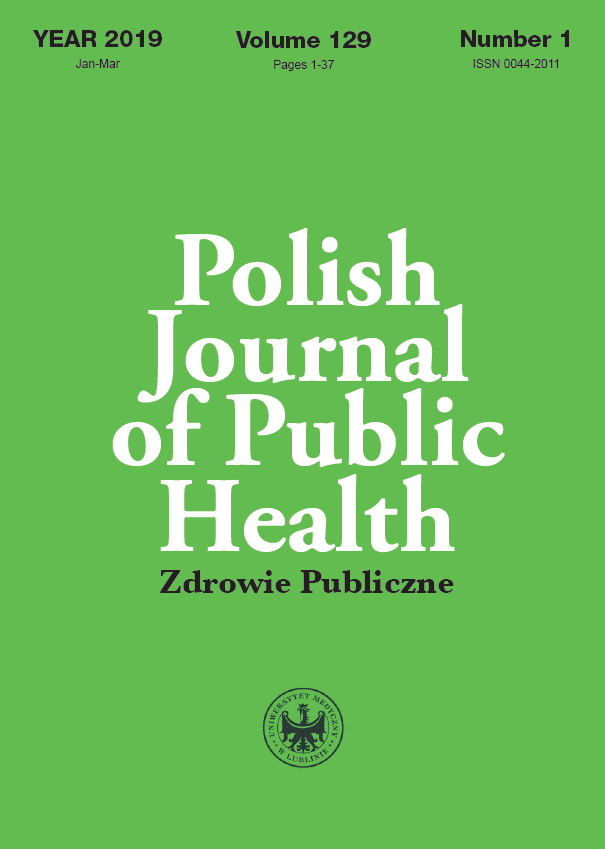Prevention of cardiovascular disease and eating behaviour in postmenopausal women
DOI:
https://doi.org/10.2478/pjph-2019-0004Keywords:
cardiovascular disease, menopause, prevention, assessment of nutrition, dietary habits, dietary knowledgeAbstract
Introduction. A balanced diet can help to prevent cardiovascular diseases. It particularly applies to the increased risk patients, including postmenopausal women with dyslipidaemia.
Aim. The aim of this study was to assess dietary habits, and consumption of selected nutrients which may have influence on the cardiovascular risk and determine nutritional knowledge in the group of women.
Material and methods. The study was conducted in 60 postmenopausal women with dyslipidaemia. The nutritional status was assessed on the basis of anthropometric measurements. The assessment of nutrition was evaluated using a 24-hour dietary recall during 4 days. Based on the authors’ questionnaire, dietary habits and the level of knowledge on the cardiovascular risk factors were assessed.
Results. The diet of the studied group of women was characterized by excessive supply of energy derived from fat and inappropriate supply of cholesterol, dietary fiber, sodium and vitamin D. Based on the assessed dietary habits, it was shown that the patients preferred foods with reduced fat content and mostly added salt for preparing their meals. Knowledge of factors affecting cardiovascular risk was insufficient.
Conclusions. Inadequate diet with insufficient nutritional knowledge in the studied group of women may significantly increase the risk of cardiovascular diseases in the future.
References
1. Nichols M, Townsend N, Scarborough P, et al. European cardiovascular disease statistics 2012 edition. Sophia Antipolis: European Heart Network; 2012.
2. Cierniak-Piotrowska M, Marciniak G, Stańczak J. Statystyka zgonów i umieralności z powodu chorób układu krążenia. In: Z. Strzelecki, J. Szymborski (ed). Zachorowalność i umieralność na choroby układu krążenia a sytuacja demograficzna Polski. Warszawa: Rządowa Rada Ludnościowa; 2015.
3. Piskorz A, Brzostek T, Piórecka B. Występowanie wybranych czynników ryzyka chorób układu krążenia w grupie kobiet w okresie przed i pomenopauzalnym – analiza porównawcza. Hygeia Public Health. 2015;50(1):127-35.
4. Reiner Ž, Catapano AL, Backer G, et al. Wytyczne ESC/EAS dotyczące postępowania w dyslipidemiach. Kardiol Pol. 2011;69(4):144-99.
5. He L, Tang X, Hu YH. Relationship of menopause with cardiovascular disease and related metabolic disorders. Beijing Da Xue Xue Bao. 2016;48(3):448-53.
6. Perk J, De Backer G, Gohlke H, et al. Wytyczne ESC dotyczące prewencji chorób układu sercowo-naczyniowego w praktyce klinicznej w 2016 roku. Kardiol Pol. 2016;74(9):821-936.
7. Goh LG, Chua T, Kang V, et al. Ministry of health clinical practice guidelines: screening of cardiovascular disease and risk factors. Singapore Med J. 2011;52(3):220-5.
8. Ventura DA, Fonseca VM, Ramos EG, et al. Association between quality of the diet and cardiometabolic risk factors in postmenopausal women. Nutr J. 2014;13(1):1-10.
9. Charzewska J. Instrukcja przeprowadzania wywiadu o spożyciu z 24 godzin. Warszawa: Instytut Żywności i Żywienia; 1998.
10. Szponar L, Wolnicka K, Rychlik E. Album fotografii produktów i potraw. Warszawa: Instytut Żywności i Żywienia; 2000.
11. Kunachowicz H, Nadolna I, Przygoda B, et al. Tabele składu i wartości odżywczej żywności. Warszawa: PZWL; 2005.
12. Jarosz M. Normy żywienia dla populacji Polski. Warszawa: Instytut Żywności i Żywienia; 2017.
13. World Health Organization (WHO). Diet, nutrition and the prevention of chronic diseases. In: WHO technical report series 916, Geneva; 2003.
14. Waśkiewicz A, Sygnowska E, Jasiński B, et al. Wartość energetyczna i odżywcza diety dorosłych mieszkańców Polski. Wyniki programu WOBASZ. Kardiol Pol. 2005;63(6):1-7.
15. Grygiel-Górniak B, Przysławski J, Stelmach-Mardas M, et al. Sposób żywienia a insulinooporność w grupie kobiet otyłych po menopauzie z dyslipidemii. Bromat Chem Toksykol. 2011;44(3):277-83.
16. Skop-Lewandowska A, Gąsior A, Zając J, et al. Ocena podaży energii oraz wybranych składników pokarmowych w całodziennych racjach pokarmowych kobiet z nadwagą i otyłością. Probl Hig Epidemiol. 2014;95(4):975-80.
17. Houston MC, Harper KJ. Potassium, magnesium, and calcium: their role in both the cause and treatment of hypertension. J Clin Hypertens. 2008;10(7):3-11.
18. He FJ, Li J, MacGregor GA. Effect of modest salt reduction on blood pressure: a meta-analysis of randomized trials. Implications for public health. J Hum Hypertens. 2002;16(11):761-70.
19. Poggio R, Gutierrez L, Matta MG, et al. Daily sodium consumption and CVD mortality in the general population: systematic review and metaanalysis of prospective studies. Public Health Nutr. 2015;18(4):695-704.
20. Gepner A, Ramamurthy R, Krueger DC, et al. A prospective randomized controlled trial of the effects of vitamin D supplementation on cardiovascular disease risk. PLoS One. 2012;7(5):e36617.
21. Dobrzyńska M, Przysławski J. Prevention of cardiovascular disease andeating behaviour in group of women and men aged 20 to 30 years. JMS.2014;2(83):116-21.
Downloads
Published
Issue
Section
License
Copyright (c) 2019 Polish Journal of Public Health

This work is licensed under a Creative Commons Attribution-NonCommercial-NoDerivatives 3.0 Unported License.


